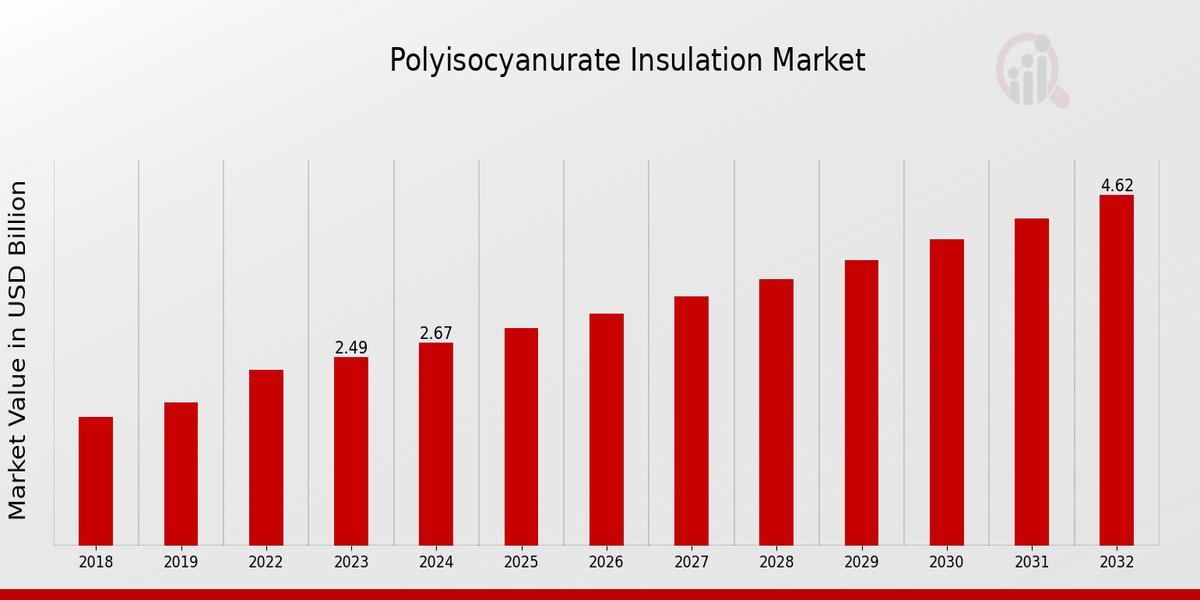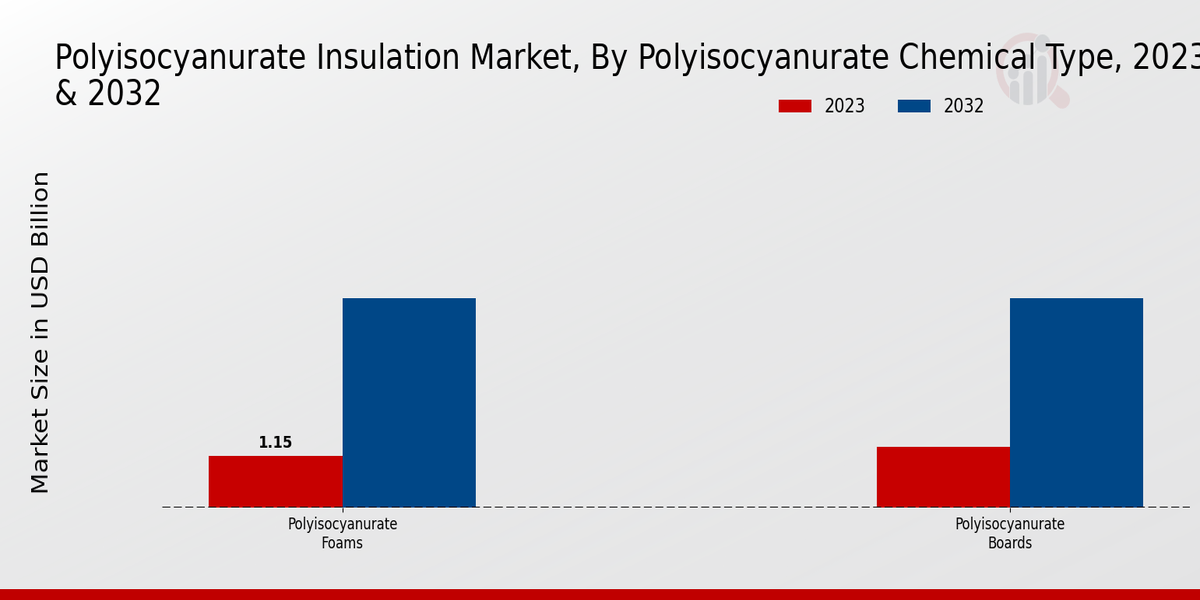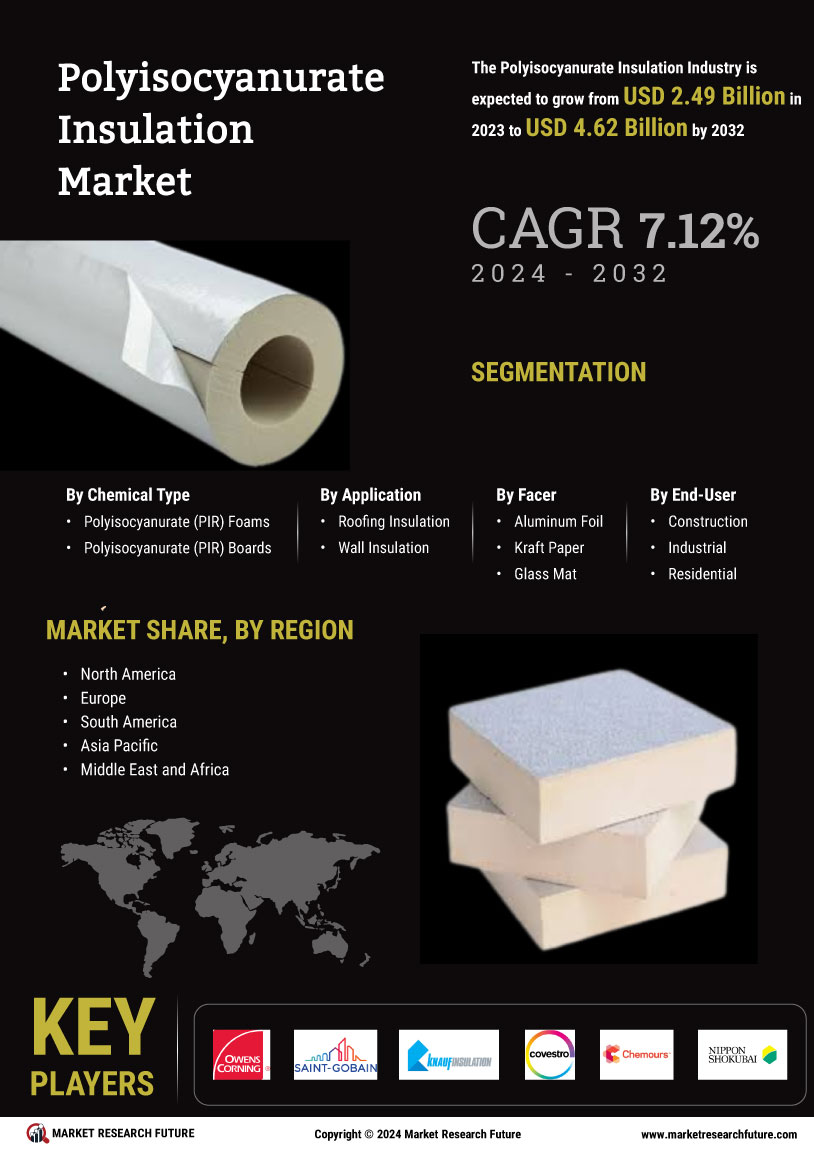Global Polyisocyanurate Insulation Market Overview
The Polyisocyanurate Insulation Market Size was estimated at USD 2.85 Billion in 2024. The Polyisocyanurate Insulation Industry is expected to grow from USD 3.05 Billion in 2025 to USD 5.67 Billion by 2034. exhibiting a compound annual growth rate (CAGR) of 7.12% during the forecast period (2025 - 2034).
Key Polyisocyanurate Insulation Market Trends Highlighted
The polyisocyanurate insulation market is witnessing significant growth, driven by increasing demand for energy-efficient building solutions. The trend towards sustainable construction and renovation projects is fueling market growth, as polyisocyanurate insulation offers exceptional thermal performance, contributing to reduced energy consumption and lower carbon emissions. The growing emphasis on fire safety regulations is also driving demand for this flame-retardant material.
Opportunities in the market include the increasing adoption of polyisocyanurate insulation in residential and commercial buildings, as well as the rising demand for high-performance insulation materials in cold and extreme weather regions. The market is also seeing increased demand for environmentally friendly insulation solutions, which is driving innovation in the development of eco-friendly polyisocyanurate insulation products.
Recent trends in the polyisocyanurate insulation market include the introduction of advanced manufacturing technologies, such as continuous lamination, which enhance production efficiency and reduce costs. The market is also witnessing a shift towards the use of bio-based polyols in the production of polyisocyanurate insulation, contributing to improved sustainability. The growing availability of customizable insulation solutions tailored to specific building requirements and performance needs is another notable trend.
 Source: Primary Research, Secondary Research, MRFR Database and Analyst Review
Source: Primary Research, Secondary Research, MRFR Database and Analyst Review
Polyisocyanurate Insulation Market Drivers
Rising Demand for Energy-Efficient Buildings
The growing consciousness regarding energy conservation and sustainability has surged the demand for energy-efficient building materials. Owing to its far better thermal resistance in comparison with other insulation materials, polyisocyanurate insulation is widely used to construct energy-efficient buildings. The insulation material manages to sufficiently lower heat loss through the building envelope, improving the building envelope performance. This lowers energy consumption and carbon emission into the atmosphere, which have to be done in the same manner in order to help people worldwide to meet the effort of cooling the planet.Hence, the market of the same industry is expected to grow during the next 5-6 years.
Expansion of Construction Activities
A driver for the Polyisocyanurate Insulation Market Industry is the growth in the construction industry in emerging economies. The increasing number of residential and commercial construction projects provides a huge opportunity for the use of polyisocyanurate insulation. Furthermore, its lightweight and easy to install serve as a plus for it and make it usable in heating, ventilation, and air conditioning. As construction activities increase, so will the pressure to make use of insulation and for this reason, there is likely to be an increase in the demand for polyisocyanurate insulation.
Stringent Building Codes and Regulations
Different authorities and governments across nations are imposing strict, energy-saving building codes and standards for insulation. For instance, jurisdictions in Oregon have implemented standards for constructing new buildings that are energy-efficient and of high quality. According to these standards, all residential and nonresidential buildings are required to be insulated with R-38 ceiling insulation and 2X4 (or 2X6) framing cavity walls. Based on the requirements of the standards, polyisocyanurate insulation is the ideal high-performance insulation material that best suits the standards that have been set up.Since manufacturers that comply with the building codes and insulation standards are herein set to benefit in terms of the demand for insulation material, the regulations will positively affect the Polyisocyanurate Insulation Market Industry.
Polyisocyanurate Insulation Market Segment Insights
Polyisocyanurate Insulation Market Polyisocyanurate Chemical Type Insights
The major types of the Polyisocyanurate Insulation Market are chemical types such as. The Polyisocyanurate Foams segment’s revenue is forecasted to reach USD 1.82 billion in 2024, and the CAGR is also estimated to be 7.5% by the end of the current time scope. Polyisocyanurate foam’s positions are favorable because the building sector’s demand for polyisocyanurate insulation is expected to grow. It is caused by the fact that energy-efficient substances in the housing and non-residential construction segment that allow one to reduce energy expenditure are taking specific positions.Polyisocyanurate Foams feature perfect thermal insulation quantity, which can help the owner pay less for heating the building in winter and cooling in summer months. For this reason, this type will remain to be the main during the projected time scope. The Polyisocyanurate Boards type is also a key position and will have revenue of USD 2.49 billion by 2024. However, this increase will be reached by a lower CAGR of 6.8%. It is expected, as the substance features unique features, such as better strength of design and good dimensional stability, which cannot be located in foam types.For this reason, old warehouses with cold storage can likely apply, as well as bedding on roofs, walls, and so on. The principal reasons to boost the Polyisocyanurate Insulation Market are raising awareness regarding energy and its savings, monitoring or permanent tightening, changes of building regulations, and the range of bans on materials’ usage. The polyiso insulation market’s action contributes to the alerting of odd-sized people about the dangerous state of the climate. On the other hand, non-residential construction’s popularity is also becoming reasonably rapid so that one can build new and reconstruct old shopping facilities or city buildings.Next, they can also construct Office Centres of Considerable Height, and other structures from sustainably-made polyiso insulation. A competent approach can be made by ending the objects with from to reduce the waste of electrical devices and pay less than other people for electricity. Additionally, the CAGR measuring up to 9.0% should not be ugly-looking and safe for life and health. However, not everybody considers these devices to be subsidies, as many people pay less than 1BTC each for white aluminum windowsills.
 Source: Primary Research, Secondary Research, MRFR Database and Analyst Review
Source: Primary Research, Secondary Research, MRFR Database and Analyst Review
Polyisocyanurate Insulation Market Application Insights
The application segment of the Polyisocyanurate Insulation Market holds significant importance, influencing the overall market growth and revenue generation. Among the key applications, Roofing Insulation dominates the market, accounting for a substantial share of the Polyisocyanurate Insulation Market revenue in 2023. The rising demand for energy-efficient building solutions and the increasing adoption of polyisocyanurate insulation in residential and commercial roofing applications drive the growth of this segment. Wall Insulation also holds a notable market share, primarily due to the growing emphasis on thermal insulation in construction projects.Furthermore, the increasing use of polyisocyanurate insulation in industrial and commercial refrigeration applications, such as cold storage facilities and warehouses, is expected to contribute to the growth of this segment in the coming years. Other applications, including pipe insulation, transportation insulation, and appliance insulation, are also expected to witness steady growth, adding to the overall Polyisocyanurate Insulation Market revenue.
Polyisocyanurate Insulation Market Facer Insights
The Polyisocyanurate Insulation Market is segmented by Facer into Aluminum Foil, Kraft Paper, Glass Mat, and Nonwoven Polyester. Among these, Aluminum Foil held the largest market share in 2023, accounting for over 35% of the revenue. This dominance is attributed to its excellent moisture resistance, durability, and reflective properties. Kraft Paper is another commonly used facer, particularly in residential and commercial buildings, due to its cost-effectiveness and ease of handling. Glass Mat offers high strength and dimensional stability, making it suitable for demanding applications such as industrial roofing and ductwork.Nonwoven Polyester, known for its flame-retardant properties and resistance to chemicals, is gaining popularity in specific applications, such as automotive and aerospace insulation. The increasing adoption of polyisocyanurate insulation in various end-use industries, coupled with the growing demand for energy-efficient building materials, is expected to drive the growth of the Facer segment in the coming years.
Polyisocyanurate Insulation Market End-User Insights
The Polyisocyanurate Insulation Market is segmented by end-user into Construction, Industrial, and Residential. The construction segment is expected to account for the largest revenue share in the Polyisocyanurate Insulation Market by 2024, owing to the increasing demand for energy-efficient building materials. The use of polyisocyanurate insulation in construction helps reduce heat loss and improve the overall energy performance of buildings, leading to its widespread adoption in residential and commercial constructions. The industrial segment is projected to grow at a significant rate due to its application in various industrial sectors, including manufacturing, transportation, and cold storage facilities.The residential segment is also expected to experience considerable growth due to the rising demand for energy-efficient homes and renovations.
Polyisocyanurate Insulation Market R-Value (Thermal Resistance) Insights
The R-value of polyisocyanurate insulation is a measure of its thermal resistance, which is the ability of the insulation to resist the flow of heat. The higher the R-value, the greater the thermal resistance and the better the insulation. The market growth is attributed to the increasing demand for energy-efficient buildings and the rising awareness of the environmental benefits of polyisocyanurate insulation. Among the different R-values, R-7 is the most commonly used in residential and commercial buildings. It provides a good balance of thermal resistance and cost-effectiveness.R-9 insulation is typically used in colder climates or in applications where maximum thermal resistance is required. The choice of R-value for polyisocyanurate insulation depends on a number of factors, including the climate, the type of building, and the desired level of energy efficiency. By choosing the right R-value, you can ensure that your building is well-insulated and energy-efficient.
Polyisocyanurate Insulation Market Regional Insights
The Polyisocyanurate Insulation Market is segmented into North America, Europe, APAC, South America, and MEA based on region. Among these regions, North America is expected to hold the largest market share in the coming years. The growth of the market in this region can be attributed to the increasing demand for energy-efficient buildings and the growing construction sector. The Polyisocyanurate Insulation Market is driven by factors such as the rising demand for energy-efficient buildings, increasing construction activities, and growing awareness about thermal insulation.The market is expected to witness significant growth in the coming years. Europe is another major market for polyisocyanurate insulation. The market in this region is driven by the increasing demand for energy-efficient buildings and stringent building regulations. The APAC region is also expected to witness significant growth in the coming years. The growth of the market in this region can be attributed to the increasing construction activities and the growing demand for energy-efficient buildings. The South American and MEA regions are also expected to witness steady growth in the coming years.The growth of the market in these regions can be attributed to the increasing demand for energy-efficient buildings and the growing construction sector. Source: Primary Research, Secondary Research, MRFR Database and Analyst Review
Source: Primary Research, Secondary Research, MRFR Database and Analyst Review
Polyisocyanurate Insulation Market Key Players And Competitive Insights:
Polyisocyanurate Insulation Market players are focusing on the development of innovative products to cater to the changing demands of the construction industry. For instance, in January 2023, Covestro AG announced the launch of a new polyisocyanurate insulation material, which combines superior thermal performance with excellent fire safety. Leading companies are also investing in production capacity expansion to cater to rising Polyisocyanurate Insulation Market demand. In June 2023, Huntsman Corporation announced its plan to invest USD 1 billion in the expansion of its production capacity for polyisocyanurate insulation material in the Asia-Pacific region. The Polyisocyanurate Insulation Market is characterized by competitive rivalry, and leading players are investing in expanding their penetration, new product development, and strategic partnerships with suppliers of insulation materials. Overall, Polyisocyanurate Insulation Market brought about fierce competition among major players in the industry, who aspire to gain ground in the market through product innovation, partnerships, and aggressive marketing efforts.Owens Corning is one of the major Polyisocyanurate Insulation Market players. The company produces a wide range of polyisocyanurate insulation products, including rigid foam boards, close-cell proto-type spray foams, open-cell spray foams, and flexible laminates. Owens Corning is a leading polyisocyanurate insulation material producer in North America and is also growing strong in the European market. In June 2023, Owens Corning announced the installation of a new line of Polyisocyanurate Insulation Market products in its production facility in Thailand. The company invests heavily in innovation and new product development to bring new insulation solutions to its customers. Owens Corning has also invested numerous efforts in minimizing the environmental footprint of its operations.BASF SE is the other major industry player in the Polyisocyanurate Insulation Market. The company manufactures a wide range of polyisocyanurate insulation products, including PIR foam boards, PIR spray foams, and PIR sandwich panels. BASF also has a strong presence and is the leading supplier of insulation products in the building and construction industry. The company invests heavily in the development of high-performance insulation solutions that are compliant with building codes and regulations. BASF is also committed to research development and sustainability. For instance, the company will double its ethylene cracker’s capacity to produce ethylene in Nanjing by 2013 and will progressively reduce its nitrogen oxide and organic output.
Key Companies in the Polyisocyanurate Insulation Market Include:
Polyisocyanurate Insulation Market Industry Developments
The polyisocyanurate insulation market is projected to reach USD 5.67 billion by 2034, exhibiting a CAGR of 7.12% during the forecast period (2025-2034). The increasing demand for energy-efficient building materials, coupled with stringent government regulations on building insulation, is primarily driving market growth. Polyisocyanurate insulation offers superior thermal resistance and fire resistance, making it a preferred choice in various construction applications. The rising construction activities in developing regions, particularly in the Asia-Pacific region, are further contributing to the market's expansion.
Polyisocyanurate Insulation Market Segmentation Insights
Polyisocyanurate Insulation Market Polyisocyanurate Chemical Type Outlook
Polyisocyanurate Insulation Market Application Outlook
Polyisocyanurate Insulation Market Facer Outlook
-
Aluminum Foil
-
Kraft Paper
-
Glass Mat
-
Nonwoven Polyester
Polyisocyanurate Insulation Market End-User Outlook
-
Construction
-
Industrial
-
Residential
Polyisocyanurate Insulation Market R-Value (Thermal Resistance) Outlook
Polyisocyanurate Insulation Market Regional Outlook
-
North America
-
Europe
-
South America
-
Asia Pacific
-
Middle East and Africa
| Report Attribute/Metric |
Details |
| Market Size 2024 |
2.85 (USD Billion) |
| Market Size 2025 |
3.05 (USD Billion) |
| Market Size 2034 |
5.67 (USD Billion) |
| Compound Annual Growth Rate (CAGR) |
7.12% (2025 - 2034) |
| Report Coverage |
Revenue Forecast, Competitive Landscape, Growth Factors, and Trends |
| Base Year |
2024 |
| Market Forecast Period |
2025 - 2034 |
| Historical Data |
2020 - 2024 |
| Market Forecast Units |
USD Billion |
| Key Companies Profiled |
Owens Corning, SaintGobain, Knauf Insulation, Covestro, The Chemours Company, Nippon Shokubai, Recticel, IcyneneLapolla Insulations, Wacker Chemie AG, Dow, Huntsman, Sika AG, BASF, Kingspan, Tosoh |
| Segments Covered |
Polyisocyanurate Chemical Type, Application, Facer, End-User, R-Value (Thermal Resistance), Regional |
| Key Market Opportunities |
Increasing adoption in construction for thermal insulationGrowing demand in cold storage and food processingExpanding applications in automotive and aerospaceRising awareness of energy efficiency benefitsGovernment regulations promoting sustainable insulation solutions |
| Key Market Dynamics |
Increasing demand for energy efficient buildingsRising awareness of thermal insulation benefitsGovernment regulations and incentivesTechnological advancements in manufacturingGrowing construction industry |
| Countries Covered |
North America, Europe, APAC, South America, MEA |
Frequently Asked Questions (FAQ) :
The Polyisocyanurate Insulation Market is projected to reach a valuation of approximately USD 2.85 Billion in 2024.
The Polyisocyanurate Insulation Market is estimated to exhibit a CAGR of around 7.12% during the forecast period of 2025 to 2034.
Asia-Pacific is expected to lead the Polyisocyanurate Insulation Market by 2034, primarily driven by the increasing demand for energy-efficient building materials in the region
Polyisocyanurate Insulation finds extensive applications in various sectors, including residential and commercial buildings, industrial facilities, and transportation, owing to its superior thermal insulation properties
The Polyisocyanurate Insulation Market is highly competitive, with prominent players including BASF SE, Covestro AG, Huntsman International LLC, Dow Inc., and Kingspan Group
The increasing demand for energy-efficient construction, coupled with stringent building regulations and rising environmental concerns, are key growth drivers for the Polyisocyanurate Insulation Market.
Fluctuating raw material prices, stringent environmental regulations, and competition from alternative insulation materials pose potential challenges to the growth of the Polyisocyanurate Insulation Market.
The Polyisocyanurate Insulation Market is projected to reach a valuation of approximately USD 5.67 Billion by 2034, registering a significant growth from 2024
The residential buildings segment is expected to dominate the Polyisocyanurate Insulation Market, owing to the rising demand for energy-efficient homes
The COVID-19 pandemic had a moderate impact on the Polyisocyanurate Insulation Market, primarily due to disruptions in supply chains and construction activities. However, the market is anticipated to recover as economic activities resume.






 Source: Primary Research, Secondary Research, MRFR Database and Analyst Review
Source: Primary Research, Secondary Research, MRFR Database and Analyst Review Source: Primary Research, Secondary Research, MRFR Database and Analyst Review
Source: Primary Research, Secondary Research, MRFR Database and Analyst Review Source: Primary Research, Secondary Research, MRFR Database and Analyst Review
Source: Primary Research, Secondary Research, MRFR Database and Analyst Review







